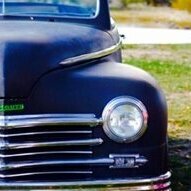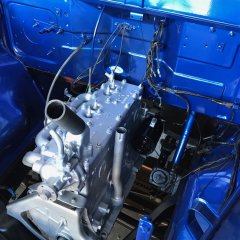
kencombs
Members-
Posts
3,085 -
Joined
-
Last visited
-
Days Won
29
kencombs last won the day on March 13
kencombs had the most liked content!
Reputation
1,057 ExcellentAbout kencombs
- Birthday 02/11/1943
Profile Information
-
Gender
Male
-
Location
claremore, ok
-
Interests
old trucks obviously, any 30/40/50 vehicle. Woodworking, welding, painting etc.
-
My Project Cars
56 1/2T
Contact Methods
-
Yahoo
kencombs22@icloud.com
-
Occupation
ret
Converted
-
Location
claremore ok
-
Interests
old cars and woodworking
Recent Profile Visitors
The recent visitors block is disabled and is not being shown to other users.
-
Lots of truth there! especially the last paragraph. I'm electing to use my original '56 pickup rear end. I have most of the pieces for the disk brake on the pinion you mentioned and will need them as I'm installed a 4spd OD, A833. . For those keeping the original trans it seems that it would be fairly easy to adapt a disk to the spot where the drum/band are located. Lots of disk sources, motorcycle and even go cart parts are available, and used are fairly cheap. In my case I need to devise a support to mount the caliper and adapt the cable arrangement. Since I have no illusions that it is really and 'emergency' brake, just a parking brake, it should meet my expectations.
-
Not really common IME, but what is common is folks putting those rings in backward. If you look closely at at an external snap ring you'll see that one side is very sharp, maybe even with a little 'lip' extending from the edge. The other will be slightly rounded, very slightly. This is the result of the manufacturing process, they are stamped from a steel blank before heat treating. If the rounded side is facing away from the load it can lead to being wedged from the groove, possibly breakage as it comes out. The other thing that happens a lot is over expansion when installing weakening the ring. Wrong tool used or just gorilla hands.
-
I would suspect a brake adjustment problem also. Push rod, maybe but the direction of travel part of the problem makes me think one or both shoes are touching the drum at rest, then grab when turned. What nut are you referring to as a 'wheel nut', cam or anchor? In any case, follow the directions others have provided and that should work.
-
The only place in the code that I'm aware of that addresses light switch power source or wiring is the fairly new requirement that all switch location include a neutral. The old switch leg method did not provide for that. That is to support a lot of newer smart switches, lighted switches etc.
-
When it is misbehaving, does spark look the same on all cylinders? Could be a clue there if only 1/2 of them vs random vs all, etc. 1/2 because of the dual coil setup (internal to the coil) that I think it has where half of it fires half of the cylinders. Or if it's all then that points to sensor/control circuit. Crank position sensor came to mind first, but you've replaced that I think. Non-original parts are suspect these days though. Bad ECM ground? I'd be tempted to run a separate ground wire, ECM, Chassis, engine just to rule out.
-
That pic is misleading, IMO. They show a pulley/hub combo then just the hub, but no pulley to attach to the hub shown. Some years had separate pulleys that bolted to the hub, others has a one piece pulley/hub. So they've tried to show too much in one illustration. The ones I've seen with the separate pieces had a hub, pulley and dampener. The on the multipiece the hub goes on first, then the bolt on part, whether dampener or just a pulley. Aftermarket documentation, tends to have a lot of errors like that, as compared to factory manuals.
-
How to clean a camshaft without stripping embedded oil?
kencombs replied to ktb's topic in Mopar Flathead Truck Forum
All I'll say is that I've been working on engine internals since 1959. Cams, cranks, blocks etc. Disassembled, cleaned, reassembled and installed. Never have I concerned myself with that question. Oh, and most of them ran when I finished. -
That was common on a lot of Chrysler stuff up through at least '59 even on V8s with auto and torque converters. You'll need a special or modified wrench to deal with limited room, at least I did. Long pattern, 5/8"(I think) box end, 12 pt ground down a bit for clearance.
-
Or, go to a John Deere dealler and gut a tube of'corn head grease'. Thick and won't leak out but thins under pressure, lubing the sliding contact areas.
-
I drove my Dad's 54 as my 'date' car in high school. My old chevy wasn't nice enough for my girl friends. Assuming yours is a Powerflite, it is the same chassis and mechanically similar except his had the 241cu hemi, the 56 is probably be a 270 A series which is a great engine. There where other engine options but most were not often found in the Coronet line. edit to add: being 16 at the time and a budding hot rodder, I can attest that there are no weaknesses in the running gear. Just about unbreakable, even to a teen boy.
-
Just a word of caution with the spin-on replacements. There are a lot of filters that will physically fit the adapter. But, most are not rated for bypass duty, but for full flow. The bypass filters have a much smaller 'pass' rating, catching stuff that a full flow will let through. You can buy the bypass replacement for a small diesel to be sure. For instance the Mitsubishi Fuso 3.9L diesel I had used two filters that looked identical, except for the printed part number. One for full flow and one for bypass. I think I'll try to replicate that on my 230 just to see if I can. It's already drilled, tapped and plugged for full flow. Just have to make the lines. Then use a similar mounting base on the other side for the bypass. Maybe this year I'll finish.
-
That oil pressure relief valve mentioned should be installed behind the bigger plug at the bottom of your pic. And, probably is, or the engine would have no oil pressure. That is the key to making a bypass system work, only after the oil pressure/flow needs of the bearings is met does it open and allow oil to flow to the filter.
-
Is the OD the same as the seal on the left, but only a different ID? If so,I'd guess that it is included to make the kit fit multiple applications, maybe with different residual pressure valves. Cheaper to do that than stock two different part numbers.




